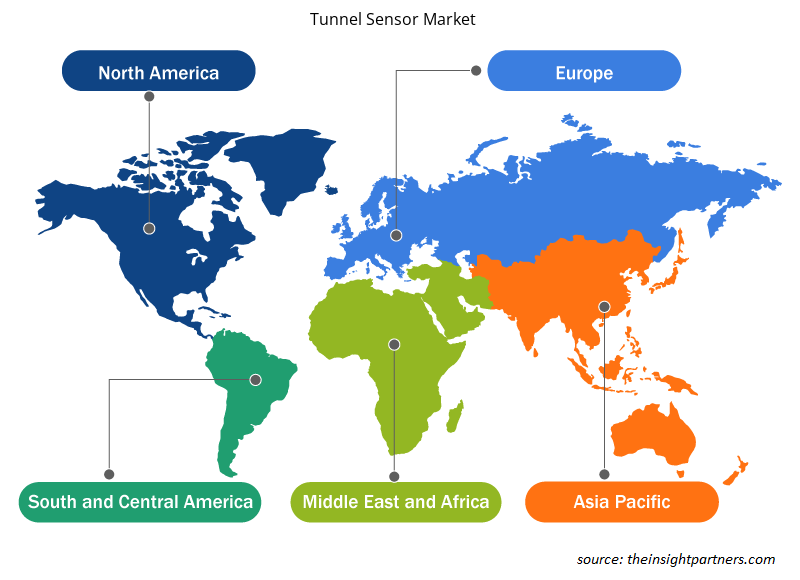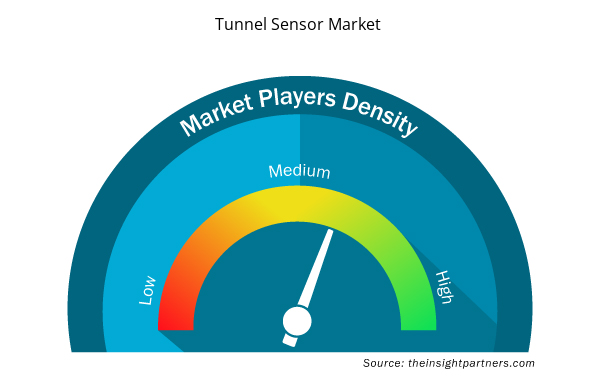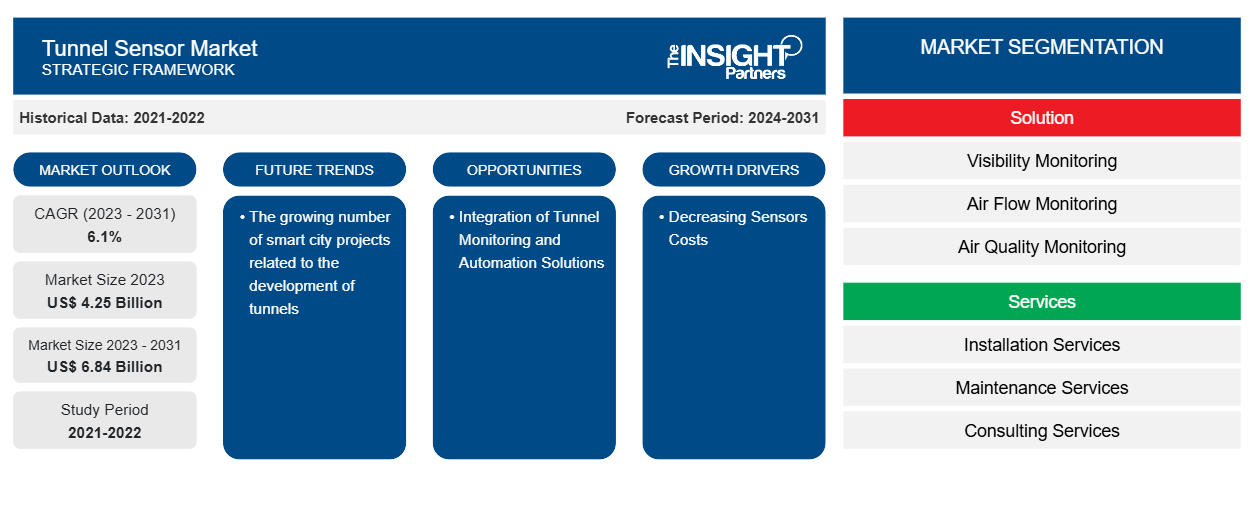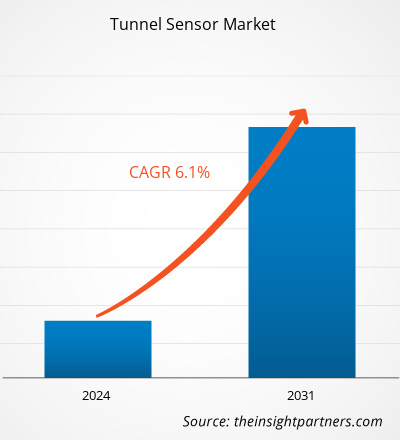Der Markt für Tunnelsensoren soll von 4,25 Milliarden US-Dollar im Jahr 2023 auf 6,84 Milliarden US-Dollar im Jahr 2031 anwachsen. Der Markt soll zwischen 2023 und 2031 eine durchschnittliche jährliche Wachstumsrate (CAGR) von 6,1 % verzeichnen. Die wachsende Zahl von Smart-City-Projekten im Zusammenhang mit dem Bau von Tunneln dürfte ein wichtiger Trend auf dem Markt für Tunnelsensoren bleiben.
Marktanalyse für Tunnelsensoren
Der Markt für Tunnelsensoren wächst rasant, da die Sensorkosten sinken und die Regierung Initiativen zur Förderung der Infrastrukturentwicklung ergreift. Der Markt wächst stetig, angetrieben durch die zunehmende Digitalisierung und Urbanisierung. Darüber hinaus bietet die Integration von Tunnelüberwachungs- und Automatisierungslösungen lukrative Möglichkeiten für Marktwachstum.
Marktübersicht für Tunnelsensoren
Tunnelsensoren sind elektrische Geräte, die zur Steuerung und Überwachung der Umgebung in Eisenbahn-, Straßen- oder anderen Tunneln verwendet werden. Diese Sensoren sind dafür ausgelegt, die Luftkonzentrationen im Tunnel zu verfolgen und zu bewerten. Ein Sender und ein Empfänger sind auf dem Dach des Tunnels montiert. Der Sender sendet sichtbare und infrarote LEDs aus, um die Sichtbarkeit und Gaskonzentration in der Röhre zu messen. Die erhaltenen Signale werden dann im Rahmen des Luftqualitätsmanagements zur Belüftungssteuerung in diesen Tunneln verarbeitet . Darüber hinaus beflügeln die erheblichen Vorteile von Tunnelsensoren, wie z. B. die Beurteilung des Tunnelzustands, die Identifizierung chemischer Gefahren und die Messung von Luftfeuchtigkeit und Temperatur sowie anderer Parameter, den Markt.
Passen Sie diesen Bericht Ihren Anforderungen an
Sie erhalten kostenlose Anpassungen an jedem Bericht, einschließlich Teilen dieses Berichts oder einer Analyse auf Länderebene, eines Excel-Datenpakets sowie tolle Angebote und Rabatte für Start-ups und Universitäten.
- Holen Sie sich die wichtigsten Markttrends aus diesem Bericht.Dieses KOSTENLOSE Beispiel umfasst eine Datenanalyse von Markttrends bis hin zu Schätzungen und Prognosen.
Treiber und Chancen auf dem Tunnelsensormarkt
Sinkende Sensorkosten treiben den Markt an
Sensoren sind Schlüsselkomponenten von Tunnelüberwachungssystemen. Sie werden verwendet, um Druck, Dehnung, Kraft, Vibration, Temperatur und andere Parameter zu messen, die für die Bestimmung des Zustands einer Tunnelkonstruktion entscheidend sind. Tunnelüberwachungssysteme werden durch die weit verbreitete Nutzung moderner Sensortechnologien, die die Kosten der gesamten Sensoren senken, immer intelligenter und fortschrittlicher. Dies treibt den Markt an. Mikroelektromechanische Systeme (MEMS) und faseroptische Sensoren werden im Tunnelbau häufig eingesetzt, was auf ihre Beliebtheit, fortschrittlichen Funktionen und Verfügbarkeit zu niedrigen Kosten zurückzuführen ist. Die kostengünstige Verfügbarkeit von Tunnelsensoren treibt den Markt im Prognosezeitraum an.Micro-electro-mechanical systems (MEMS) and fiber-optic sensors are highly adopted in tunnel construction, attributed to their popularity, advanced features, and availability at low costs. The low-cost availability of tunnel sensors is driving the market during the forecast period.
Integration von Tunnelüberwachungs- und Automatisierungslösungen – eine Chance auf dem Tunnelsensormarkt
Die digitale Transformation revolutioniert Branchen auf der ganzen Welt aufgrund mehrerer Vorteile, wie z. B. besserer Betriebseffizienz, Produktivität und niedrigeren Preisen. Unternehmen weltweit investieren massiv in die Entwicklung digitaler Technologien wie Cloud Computing, Web-/Mobil-Apps, Big Data, Predictive Analytics und das Internet der Dinge, um Tunnelüberwachungssysteme zu automatisieren, die Tunnelwartungskosten zu senken und die Häufigkeit von Vorfällen zu reduzieren. Tunnelautomatisierungssysteme bieten wichtige strategische Vorteile, darunter niedrigere Kosten, höhere Genauigkeit, verbesserte Leistung, Umweltvorteile und verbesserte Einhaltung gesetzlicher Vorschriften. Darüber hinaus schafft die Zahl der staatlichen Gesetze, die die Einführung von Tunnelautomatisierungssystemen fördern , Wachstumschancen für den Markt. Darüber hinaus schaffen der technologische Fortschritt und die wachsende Nachfrage nach Automatisierungslösungen bei Kunden weltweit im Prognosezeitraum Chancen für Teilnehmer am Tunnelsensormarkt.
Segmentierungsanalyse des Tunnelsensor-Marktberichts
Wichtige Segmente, die zur Ableitung der Tunnelsensor-Marktanalyse beigetragen haben, sind Lösung, Dienste, Konnektivität und Anwendung.
- Basierend auf der Lösung ist der Markt für Tunnelsensoren in Sichtbarkeitsüberwachung, Luftstromüberwachung, Luftqualitätsüberwachung, Filterüberwachung, Brandüberwachung und andere unterteilt. Das Segment Luftqualitätsüberwachung hatte im Jahr 2023 einen größeren Marktanteil.
- In Bezug auf Dienstleistungen wird der Markt in Installationsdienste, Wartungsdienste und Beratungsdienste unterteilt. Das Segment Installationsdienste hatte im Jahr 2023 einen größeren Marktanteil.
- Basierend auf der Konnektivität ist der Markt für Tunnelsensoren in kabelgebundene und kabellose unterteilt. Das kabelgebundene Segment hatte im Jahr 2023 einen größeren Marktanteil.
- Auf der Grundlage der Anwendung ist der Markt in Straßentunnel, Eisenbahntunnel und andere unterteilt. Das Segment Straßentunnel hielt im Jahr 2023 den größten Marktanteil.
Tunnelsensor-Marktanteilsanalyse nach Geografie
Der geografische Umfang des Tunnelsensor-Marktberichts ist hauptsächlich in fünf Regionen unterteilt: Nordamerika, Asien-Pazifik, Europa, Naher Osten und Afrika sowie Südamerika/Süd- und Mittelamerika.
In Bezug auf den Umsatz hatte der asiatisch-pazifische Raum den größten Marktanteil bei Tunnelsensoren. Der Markt in dieser Region ist in Australien, China, Japan, Indien, Südkorea und den Rest des asiatisch-pazifischen Raums unterteilt. Aufgrund wachsender Aktivitäten zur Entwicklung der Infrastruktur wird für den asiatisch-pazifischen Raum in naher Zukunft ein deutliches Wachstum erwartet. Darüber hinaus treiben der zunehmende Tunnelbau und die Renovierung in China, Indien und Japan, die zunehmende Urbanisierung und positive Initiativen der Regierung zum Ausbau von Autobahnen und Eisenbahnen den Markt im Prognosezeitraum an.
Regionale Einblicke in den Tunnelsensormarkt
Die regionalen Trends und Faktoren, die den Tunnelsensormarkt während des Prognosezeitraums beeinflussen, wurden von den Analysten von Insight Partners ausführlich erläutert. In diesem Abschnitt werden auch die Marktsegmente und die Geografie von Tunnelsensoren in Nordamerika, Europa, im asiatisch-pazifischen Raum, im Nahen Osten und Afrika sowie in Süd- und Mittelamerika erörtert.

- Erhalten Sie regionale Daten zum Tunnelsensormarkt
Umfang des Marktberichts zu Tunnelsensoren
| Berichtsattribut | Details |
|---|---|
| Marktgröße im Jahr 2023 | 4,25 Milliarden US-Dollar |
| Marktgröße bis 2031 | 6,84 Milliarden US-Dollar |
| Globale CAGR (2023 - 2031) | 6,1 % |
| Historische Daten | 2021-2022 |
| Prognosezeitraum | 2024–2031 |
| Abgedeckte Segmente | Nach Lösung
|
| Abgedeckte Regionen und Länder | Nordamerika
|
| Marktführer und wichtige Unternehmensprofile |
|
Marktteilnehmerdichte für Tunnelsensoren: Auswirkungen auf die Geschäftsdynamik verstehen
Der Markt für Tunnelsensoren wächst rasant, angetrieben durch die steigende Nachfrage der Endnutzer aufgrund von Faktoren wie sich entwickelnden Verbraucherpräferenzen, technologischen Fortschritten und einem größeren Bewusstsein für die Vorteile des Produkts. Mit steigender Nachfrage erweitern Unternehmen ihr Angebot, entwickeln Innovationen, um die Bedürfnisse der Verbraucher zu erfüllen, und nutzen neue Trends, was das Marktwachstum weiter ankurbelt.
Die Marktteilnehmerdichte bezieht sich auf die Verteilung von Firmen oder Unternehmen, die in einem bestimmten Markt oder einer bestimmten Branche tätig sind. Sie gibt an, wie viele Wettbewerber (Marktteilnehmer) in einem bestimmten Marktraum im Verhältnis zu seiner Größe oder seinem gesamten Marktwert präsent sind.
Die wichtigsten auf dem Tunnelsensormarkt tätigen Unternehmen sind:
- Bristol Industrial & Research Associates Ltd.
- CODEL International Ltd.
- DURAG-GRUPPE
- Advanced Technologies Asia Sdn. Bhd.
- ACOEM
- Steuergeräte Pty Ltd.
Haftungsausschluss : Die oben aufgeführten Unternehmen sind nicht in einer bestimmten Reihenfolge aufgeführt.

- Überblick über die wichtigsten Akteure auf dem Tunnelsensormarkt
Neuigkeiten und aktuelle Entwicklungen zum Tunnelsensormarkt
Der Markt für Tunnelsensoren wird durch die Erhebung qualitativer und quantitativer Daten nach Primär- und Sekundärforschung bewertet, die wichtige Unternehmensveröffentlichungen, Verbandsdaten und Datenbanken umfasst. Im Folgenden finden Sie eine Liste der Entwicklungen auf dem Markt für Tunnelsensorsysteme und -strategien:
- Im Oktober 2022 stellten Acoem Tunnel Sensors und Deviteck ihr Produktportfolio vom 26. bis 28. Oktober auf dem Andean Tunnel Seminar in Bogotá aus. (Quelle: ACOEM, Pressemitteilung, 2022)
Marktbericht zu Tunnelsensoren – Abdeckung und Ergebnisse
Der Bericht „Marktgröße und Prognose für Tunnelsensoren (2021–2031)“ bietet eine detaillierte Analyse des Marktes, die die folgenden Bereiche abdeckt:
- Marktgröße und Prognose auf globaler, regionaler und Länderebene für alle wichtigen Marktsegmente, die im Rahmen des Projekts abgedeckt sind
- Marktdynamik wie Treiber, Beschränkungen und wichtige Chancen
- Wichtige Zukunftstrends
- Detaillierte PEST/Porters Five Forces- und SWOT-Analyse
- Globale und regionale Marktanalyse mit wichtigen Markttrends, wichtigen Akteuren, Vorschriften und aktuellen Marktentwicklungen
- Branchenlandschaft und Wettbewerbsanalyse, einschließlich Marktkonzentration, Heatmap-Analyse, prominenten Akteuren und aktuellen Entwicklungen
- Detaillierte Firmenprofile
- Historische Analyse (2 Jahre), Basisjahr, Prognose (7 Jahre) mit CAGR
- PEST- und SWOT-Analyse
- Marktgröße Wert/Volumen – Global, Regional, Land
- Branche und Wettbewerbsumfeld
- Excel-Datensatz


- Authentication and Brand Protection Market
- Equipment Rental Software Market
- Pharmacovigilance and Drug Safety Software Market
- Aerospace Forging Market
- Hot Melt Adhesives Market
- USB Device Market
- Space Situational Awareness (SSA) Market
- Bioremediation Technology and Services Market
- Lyophilization Services for Biopharmaceuticals Market
- Enteral Nutrition Market

Report Coverage
Revenue forecast, Company Analysis, Industry landscape, Growth factors, and Trends

Segment Covered
This text is related
to segments covered.

Regional Scope
North America, Europe, Asia Pacific, Middle East & Africa, South & Central America

Country Scope
This text is related
to country scope.
Häufig gestellte Fragen
The global tunnel sensor market was estimated to be US$ 4.25 billion in 2023 and is expected to grow at a CAGR of 6.1% during the forecast period 2023 - 2031.
Decreasing sensors costs and favorable initiatives taken by the government to promote infrastructure development activities are the major factors that propel the global tunnel sensor market.
The growing number of smart city projects related to the development of tunnels is anticipated to play a significant role in the global tunnel sensor market in the coming years.
The key players holding majority shares in the global tunnel sensor market are Bristol Industrial & Research Associates Ltd., CODEL International Ltd., DURAG GROUP, Advance Technologies Asia Sdn. Bhd., and ACOEM.
The global tunnel sensor market is expected to reach US$ 6.84 billion by 2031.
The incremental growth expected to be recorded for the global tunnel sensor market during the forecast period is US$ 2.60 billion.
Trends and growth analysis reports related to Electronics and Semiconductor : READ MORE..
The Insight Partners performs research in 4 major stages: Data Collection & Secondary Research, Primary Research, Data Analysis and Data Triangulation & Final Review.
- Data Collection and Secondary Research:
As a market research and consulting firm operating from a decade, we have published and advised several client across the globe. First step for any study will start with an assessment of currently available data and insights from existing reports. Further, historical and current market information is collected from Investor Presentations, Annual Reports, SEC Filings, etc., and other information related to company’s performance and market positioning are gathered from Paid Databases (Factiva, Hoovers, and Reuters) and various other publications available in public domain.
Several associations trade associates, technical forums, institutes, societies and organization are accessed to gain technical as well as market related insights through their publications such as research papers, blogs and press releases related to the studies are referred to get cues about the market. Further, white papers, journals, magazines, and other news articles published in last 3 years are scrutinized and analyzed to understand the current market trends.
- Primary Research:
The primarily interview analysis comprise of data obtained from industry participants interview and answers to survey questions gathered by in-house primary team.
For primary research, interviews are conducted with industry experts/CEOs/Marketing Managers/VPs/Subject Matter Experts from both demand and supply side to get a 360-degree view of the market. The primary team conducts several interviews based on the complexity of the markets to understand the various market trends and dynamics which makes research more credible and precise.
A typical research interview fulfils the following functions:
- Provides first-hand information on the market size, market trends, growth trends, competitive landscape, and outlook
- Validates and strengthens in-house secondary research findings
- Develops the analysis team’s expertise and market understanding
Primary research involves email interactions and telephone interviews for each market, category, segment, and sub-segment across geographies. The participants who typically take part in such a process include, but are not limited to:
- Industry participants: VPs, business development managers, market intelligence managers and national sales managers
- Outside experts: Valuation experts, research analysts and key opinion leaders specializing in the electronics and semiconductor industry.
Below is the breakup of our primary respondents by company, designation, and region:

Once we receive the confirmation from primary research sources or primary respondents, we finalize the base year market estimation and forecast the data as per the macroeconomic and microeconomic factors assessed during data collection.
- Data Analysis:
Once data is validated through both secondary as well as primary respondents, we finalize the market estimations by hypothesis formulation and factor analysis at regional and country level.
- Macro-Economic Factor Analysis:
We analyse macroeconomic indicators such the gross domestic product (GDP), increase in the demand for goods and services across industries, technological advancement, regional economic growth, governmental policies, the influence of COVID-19, PEST analysis, and other aspects. This analysis aids in setting benchmarks for various nations/regions and approximating market splits. Additionally, the general trend of the aforementioned components aid in determining the market's development possibilities.
- Country Level Data:
Various factors that are especially aligned to the country are taken into account to determine the market size for a certain area and country, including the presence of vendors, such as headquarters and offices, the country's GDP, demand patterns, and industry growth. To comprehend the market dynamics for the nation, a number of growth variables, inhibitors, application areas, and current market trends are researched. The aforementioned elements aid in determining the country's overall market's growth potential.
- Company Profile:
The “Table of Contents” is formulated by listing and analyzing more than 25 - 30 companies operating in the market ecosystem across geographies. However, we profile only 10 companies as a standard practice in our syndicate reports. These 10 companies comprise leading, emerging, and regional players. Nonetheless, our analysis is not restricted to the 10 listed companies, we also analyze other companies present in the market to develop a holistic view and understand the prevailing trends. The “Company Profiles” section in the report covers key facts, business description, products & services, financial information, SWOT analysis, and key developments. The financial information presented is extracted from the annual reports and official documents of the publicly listed companies. Upon collecting the information for the sections of respective companies, we verify them via various primary sources and then compile the data in respective company profiles. The company level information helps us in deriving the base number as well as in forecasting the market size.
- Developing Base Number:
Aggregation of sales statistics (2020-2022) and macro-economic factor, and other secondary and primary research insights are utilized to arrive at base number and related market shares for 2022. The data gaps are identified in this step and relevant market data is analyzed, collected from paid primary interviews or databases. On finalizing the base year market size, forecasts are developed on the basis of macro-economic, industry and market growth factors and company level analysis.
- Data Triangulation and Final Review:
The market findings and base year market size calculations are validated from supply as well as demand side. Demand side validations are based on macro-economic factor analysis and benchmarks for respective regions and countries. In case of supply side validations, revenues of major companies are estimated (in case not available) based on industry benchmark, approximate number of employees, product portfolio, and primary interviews revenues are gathered. Further revenue from target product/service segment is assessed to avoid overshooting of market statistics. In case of heavy deviations between supply and demand side values, all thes steps are repeated to achieve synchronization.
We follow an iterative model, wherein we share our research findings with Subject Matter Experts (SME’s) and Key Opinion Leaders (KOLs) until consensus view of the market is not formulated – this model negates any drastic deviation in the opinions of experts. Only validated and universally acceptable research findings are quoted in our reports.
We have important check points that we use to validate our research findings – which we call – data triangulation, where we validate the information, we generate from secondary sources with primary interviews and then we re-validate with our internal data bases and Subject matter experts. This comprehensive model enables us to deliver high quality, reliable data in shortest possible time.


 Holen Sie sich ein kostenloses Muster für diesen Bericht
Holen Sie sich ein kostenloses Muster für diesen Bericht